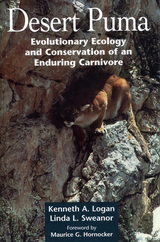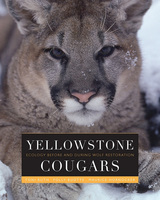2 books by Hornocker, Maurice G.

Desert Puma
Evolutionary Ecology And Conservation Of An Enduring Carnivore
Kenneth A. Logan and Linda L. Sweanor; Foreword by Maurice G. Hornocker
Island Press, 2001
Scientists and conservationists are beginning to understand the importance of top carnivores to the health and integrity of fully functioning ecosystems. As burgeoning human populations continue to impinge on natural landscapes, the need for understanding carnivore populations and how we affect them is becoming increasingly acute.Desert Puma represents one of the most detailed assessments ever produced of the biology and ecology of a top carnivore. The husband-and-wife team of Kenneth Logan and Linda Sweanor set forth extensive data gathered from their ten-year field study of pumas in the Chihuahua Desert of New Mexico, also drawing on other reliable scientific data gathered throughout the puma's geographic range. Chapters examine: the evolutionary and modern history of pumas, their taxonomy, and physical description a detailed description and history of the study area in the Chihuahua Desert field techniques that were used in the research puma population dynamics and life history strategies the implications of puma behavior and social organization the relationships of pumas and their preyThe authors provide important new information about both the biology of pumas and their evolutionary ecology -- not only what pumas do, but why they do it. Logan and Sweanor explain how an understanding of puma evolutionary ecology can, and must, inform long-term conservation strategies. They end the book with their ideas regarding strategies for puma management and conservation, along with a consideration of the future of pumas and humans. Desert Puma makes a significant and original contribution to the science not only of pumas in desert ecosystems but of the role of top predators in all environments. It is an essential contribution to the bookshelf of any wildlife biologist or conservationist involved in large-scale land management or wildlife management.
[more]

Yellowstone Cougars
Ecology before and during Wolf Restoration
Toni K. Ruth
University Press of Colorado, 2018
Yellowstone Cougars examines the effect of wolf restoration on the cougar population in Yellowstone National Park—one of the largest national parks in the American West. No other study has ever specifically addressed the theoretical and practical aspects of competition between large carnivores in North America. The authors provide a thorough analysis of cougar ecology, how they interact with and are influenced by wolves—their main competitor—and how this knowledge informs management and conservation of both species across the West.
Of practical importance, Yellowstone Cougars addresses the management and conservation of multiple carnivores in increasingly human-dominated landscapes. The authors move beyond a single-species approach to cougar management and conservation to one that considers multiple species, which was impossible to untangle before wolf reestablishment in the Yellowstone area provided biologists with this research opportunity.
Yellowstone Cougars provides objective scientific data at the forefront of understanding cougars and large carnivore community structure and management issues in the Greater Yellowstone Ecosystem, as well as in other areas where wolves and cougars are reestablishing. Intended for an audience of scientists, wildlife managers, conservationists, and academics, the book also sets a theoretical precedent for writing about competition between carnivorous mammals.
Of practical importance, Yellowstone Cougars addresses the management and conservation of multiple carnivores in increasingly human-dominated landscapes. The authors move beyond a single-species approach to cougar management and conservation to one that considers multiple species, which was impossible to untangle before wolf reestablishment in the Yellowstone area provided biologists with this research opportunity.
Yellowstone Cougars provides objective scientific data at the forefront of understanding cougars and large carnivore community structure and management issues in the Greater Yellowstone Ecosystem, as well as in other areas where wolves and cougars are reestablishing. Intended for an audience of scientists, wildlife managers, conservationists, and academics, the book also sets a theoretical precedent for writing about competition between carnivorous mammals.
[more]
READERS
Browse our collection.
PUBLISHERS
See BiblioVault's publisher services.
STUDENT SERVICES
Files for college accessibility offices.
UChicago Accessibility Resources
home | accessibility | search | about | contact us
BiblioVault ® 2001 - 2024
The University of Chicago Press









